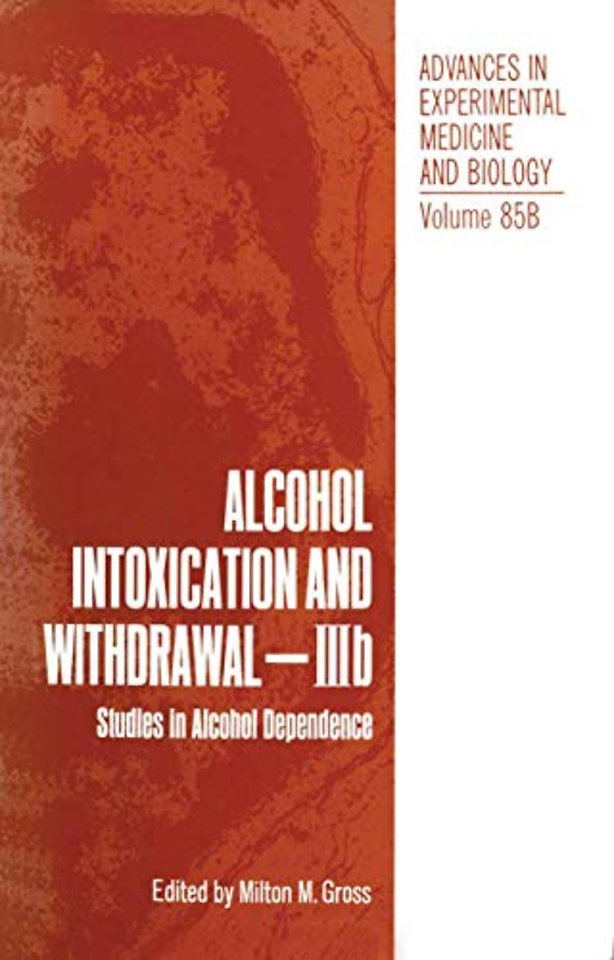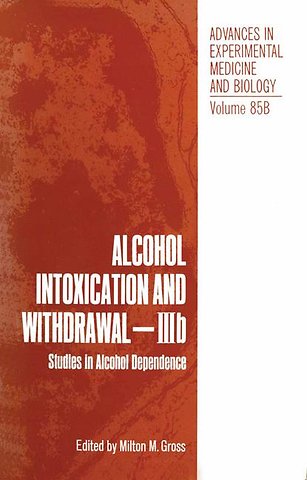of Volume III B.- Section VII. Relevance of Animal Models of Physical Dependence to the Alcohol Dependence Syndrome in Humans.- 1. Prevention of Ethanol Withdrawal Seizures in Mice by Local Anesthetics and Dextro-Propranolol.- 2. Comparison of Ethanol Withdrawal Syndrome in Humans and Rats.- 3. Barbiturate Withdrawal Syndrome in Cats.- 4. Alcohol Withdrawal Reactions in Rhesus Monkeys.- 5. Alcohol Withdrawal Syndromes in the Human: Comparison with Animal Models.- Section VIII. Comparative Mechanisms of Tolerance to and Dependence on Alcohol, Barbiturates, and Opiates.- 1. Alterations of Macromolecule Biosynthesis after Chronic Administration of Opiates and Ethanol.- 2. On the Possibility that Opiate and Ethanol Actions are Mediated by Similar Mechanisms.- 3. A Comparative Analysis of the Effects of Narcotics, Alcohol and the Barbiturates on the Hypothalamic-Pituitary-Gonadal Axis.- 4. Neuronal Aspects of Opiate Dependence and Tolerance in Comparison to Central Depressants.- 5. Opiate Receptors and Endogenous Opioid Peptides in Tolerance and Dependence.- 6. Role of Catecholamines in the Development of Tolerance to Barbiturates and Ethanol.- 7. Comparative Aspects of Tolerance to, and Dependence on, Alcohol, Barbiturates, and Opiates.- Section IX. Additional Studies in Non-Human Animals.- 1. Effects of Alcohol on Ganglion Cell Receptive Field Properties and Sensitivity in the Frog Retina.- 2. Persistence of Brain Hyperexcitability Following Chronic Alcohol Exposure in Rats.- 3. Alteration of Ethanol Preference in Hamsters: Effects of Photoperiod and 5-Hydroxytryptophan.- 4. Behavioral Changes after Chronic Ethanol Treatment.- 5. Comparison of the Effects of Alcohol, Chlordiazepoxide, and ?9-Tetrahydrocannabinol on Intraspecies Aggression in Rats.- 6. The Temporal and Volumetric Components of Stress Induced Drinking in Rats.- 7. Physiological and Behavioral Normalizing Actions of a Single Alcohol Dose in Mice.- 8. The Effects of Sodium Phenobarbital on Voluntary Ethanol Consumption in Rats.- Section X. Additional Studies In Humans.- 1. Interaction of Alcohol with Psychological Stress.- 2. The Effect of Low Dose Intravenous Alcohol on Human Information Processing.- 3. Alcohol and Interpersonal Aggression.- 4. Drinking Practices and Cognitive Functioning.- 5. Sleep in alcoholic Patients: Longitudinal Findings.- 6. The Toxicity of Ethanol: A Tentative Risk Evaluation.- 7. Introduction to the Papers on Operant Conditioning and Alcohol Intake.- 8. Metabolic and Endocrine Pathology During Hangover.- Section XI. Operant Conditioning and Alcohol Intake.- 1. Drinking of Ethanol by Rhesus Monkeys: Experimental Strategies for Establishing Ethanol as a Reinforcer.- 2. Animal Model of Alcoholism: Critique and Progress.- 3. Self-Administration of Sedatives by Humans.- 4. Chronic Alcohol Drinking and Subsequent Withdrawal in Rats Exposed to Different Diurnal Distributions of Schedule-Induction Sessions.- 5. Pharmacological Influences Upon Human Ethanol Self-Administration.- 6. Temporal Patterns of Voluntary Alcohol Intake.- Section XII. Craving and Alcohol Intake.- 1. The Dipsogenic Effect of Alcohol and the Loss of Control Phenomenon.- 2. Craving for Alcohol: Role of Drinking Pattern, Psychosocial History, Cognitive Style, Motor Control and Personality Variables.- 3. Physiologic and Situational Determinants of Drinking Behavior.- 4. Assessing the Alcoholic’s Disposition to Drink.- 5. Cue Exposure: One Approach to the Extinction of Addictive Behaviours.- 6. Thirst, Alcohol Thirst, and Control.

